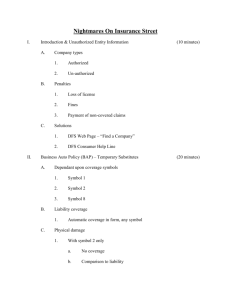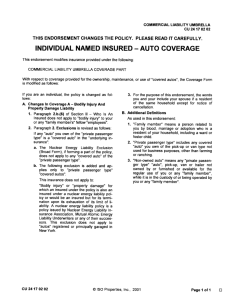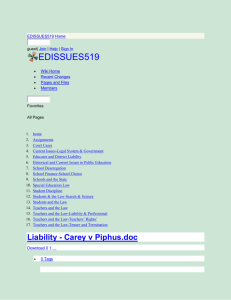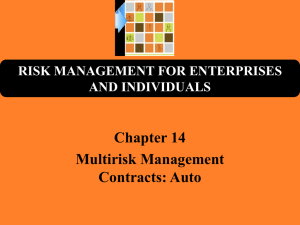have - College for Financial Planning
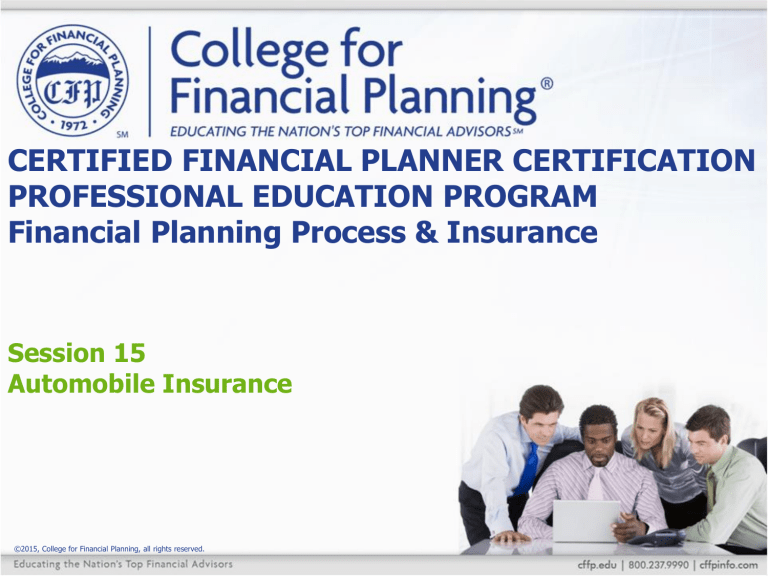
CERTIFIED FINANCIAL PLANNER CERTIFICATION
PROFESSIONAL EDUCATION PROGRAM
Financial Planning Process & Insurance
Session 15
Automobile Insurance
©2015, College for Financial Planning, all rights reserved.
Session Details
Module 9
Chapter(s) 4
LOs 9-9 Explain a characteristic of personal auto policy coverage.
15-2
Accident Claim Quotes
“Coming home I drove into the wrong house and collided with a tree I don't have.”
“I was on my way to the doctor with rear end trouble when my universal joint gave way, causing me to have an accident.”
“To avoid hitting the bumper of the car in front, I struck the pedestrian.”
“The guy was all over the road. I had to swerve a number of times before I hit him.”
“The pedestrian ran for the pavement, but I got him.”
15-3
The Planner’s Role
• Identify the amount a client can afford to lose via deductible or coverage limits
• Recognize the amount at risk with uninsured/under-insured motorists coverage
• Focus on liability issues – car lost is least financial risk
• Coordinate with umbrella coverage
• Make appropriate referrals
15-4
Potential Losses
•
There are two types of loss to assess: o Initial deductible o Policy limits
•
Factors to consider o Emergency funds to cover deductible o Umbrella coverage integration to cover liability o Net worth and/or 7x income – liability to cover o Disability coverage – uninsured/underinsured motorists o Family members – uninsured/underinsured o Health insurance
15-5
Replacement Cost or Actual Cash Value
Replacement Cost
• Cost of replacement covered up to specified preset limits
• Usually coupled with an inflation guard endorsement
Actual Cash Value (ACV)
• Essentially, replacement cost minus depreciation
• If given a choice, replacement cost is the better option
15-6
Auto Policy Structure (PAP)
• Liability coverage (the BIGGEST risk)
• Medical payments
• Uninsured motorist coverage
• Underinsured motorist coverage
• Physical damage/collision
• Physical damage/other than collision
• Duties of an insured after a loss or accident
• General provisions
15-7
Automobile Liability Coverage
• Liability coverage does not protect against loss to your own property (i.e., you cannot be liable to yourself)
• Typical split-limit liability auto coverage example: 100/300/100 o Bodily injury (liability to others) covered up to $100,000 per person o Bodily injury (liability to others) covered up to $300,000 per accident o Property damage (liability to others) covered up to $100,000
• State minimum coverage is generally inadequate coverage to meet liabilities o May be only 20/40/10
15-8
State Plans Used to Compensate Victims of Auto Accidents
Financial responsibility laws
• Provide that a driver causing bodily injury or property damage to another must demonstrate the ability to pay any claims for which he or she is found liable, up to the limits stated in the law, or lose his or her driver’s license and automobile registration
Compulsory automobile insurance laws
• Laws requiring that owners of registered automobiles have liability insurance or an approved substitute form of security
Unsatisfied judgment funds (UJF)
• Provide payment to persons injured when negligent party cannot pay for damages; collected from all motorists as fees
Uninsured motorists insurance
• Provide payment to an insured person for injuries caused by an uninsured motorist, a hit-and-run driver, or a driver whose insurance company has become insolvent
No-fault insurance
• Provides that each party collects from his or her own insurance company for any injuries sustained
15-9
No-Fault Plans
Plan
Pure
Modified
Expanded
Characteristics
Only exists in theory and in textbooks.
No right to sue.
Provides a right to sue under certain circumstances – usually for losses that exceed insurance reimbursement.
Permits lawsuits regardless of amount paid by insurer. Insurer will usually subrogate.
15-10
The Underinsured Motorists Issue
Risk: If a client or family member is seriously injured or permanently disabled, is the coverage enough?
$25,000 could be the minimum state limit. If covered with health insurance, health costs may be covered but what about loss of income or ability to earn an income?
Minimal cost to cover; may be able to cover additional under umbrella policy based on state and company.
15-11
The Personal Auto Policy (PAP)
Characteristics Provisions
Policy format • Liability coverage
• Medical payments
• Uninsured motorist coverage
• Coverage for damage to your auto
• Duties after an accident or loss
• General provisions
Section contents • Insuring agreement
• Definitions such as: o Covered persons o Covered auto o Collision o Other than by collision (comprehensive)
• Exclusions
15-12
Question 1
A client mentions that her brother and nephew are going to move in with them for the next year because they are going through a rough patch after a spouse’s death and business loss. She figures it will allow them to get back on their feet. They are going to pay some minimal rent of $200.They will be able to save expenses, such as rent and having a second car for the nephew because he will be able to use theirs. The nephew has had some trouble with drugs and alcohol this last year receiving a DUI, which they hope the counseling they are going to pay for will help. What issues should you as their planner raise?
a.
property coverage b.
automobile coverage for nephew c.
disclosure to insurance company about DUI and additional residents d.
umbrella coverage e.
all of the above
15-13
Question 2
The PAP endorsement that covers people who borrow cars is known as a.
extended liability coverage.
b.
the named non-owner endorsement.
c.
the motor home endorsement.
d.
the miscellaneous-type vehicle endorsement.
15-14
Question 3
Which one of the following systems of handling automobile claims does not allow an insured to sue another driver or the other driver’s insurance company?
a.
traditional tort system b.
pure no-fault c.
modified no-fault d.
expanded no-fault
15-15
CERTIFIED FINANCIAL PLANNER CERTIFICATION
PROFESSIONAL EDUCATION PROGRAM
Financial Planning Process & Insurance
Session 15
End of Slides
©2015, College for Financial Planning, all rights reserved.
